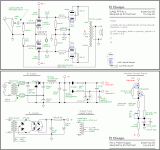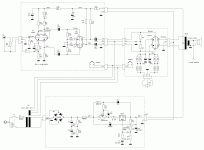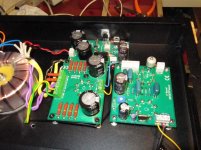Hello,
I built a pair of loudspeakers using Fostex FF165WK drivers (thanks for all who gave me advice). I housed the drivers in 18 ltr enclosures (space limitations) The result surprised me positively and I am greatly enjoying their sound.
My amplifier is a 60 watts / channel transistor amp. Because the speakers are very sensitive, I would like to try them with some tube amplifier. I should think that around 10 watts per channel would suffice nicely.
To cut to the chase, could anybody suggest some budget priced (500-1000 dollars) tube amplifier that would have a nice and balanced sound.
I live in Europe so the amp should be able to cope with 230 V power feed.
Thanking you all in advance.
Tikkis,
Helsinki, Finland
I built a pair of loudspeakers using Fostex FF165WK drivers (thanks for all who gave me advice). I housed the drivers in 18 ltr enclosures (space limitations) The result surprised me positively and I am greatly enjoying their sound.
My amplifier is a 60 watts / channel transistor amp. Because the speakers are very sensitive, I would like to try them with some tube amplifier. I should think that around 10 watts per channel would suffice nicely.
To cut to the chase, could anybody suggest some budget priced (500-1000 dollars) tube amplifier that would have a nice and balanced sound.
I live in Europe so the amp should be able to cope with 230 V power feed.
Thanking you all in advance.
Tikkis,
Helsinki, Finland
An "El Cheapo" built with better O/P transformers than shown and triode/ultra-linear mode switches meets the need. Use triode mode for "finesse" and UL mode for "grunt". Any 6V6 family tube can be used in the O/P stage, with zero parts value changes.
You will have to find some other power transformer for the low current negative rail and 12AT7/ECC81 heater power. The Allied transformer shown is "120" VAC only. OTOH, a Triad N-77U has dual primaries, which makes it "universal". A Triad VPS24-1800 (also dual primaries) takes care of "12" V. heater power and B+ boost. A Triad C-24X fills the PSU filter choke requirement.
You will have to find some other power transformer for the low current negative rail and 12AT7/ECC81 heater power. The Allied transformer shown is "120" VAC only. OTOH, a Triad N-77U has dual primaries, which makes it "universal". A Triad VPS24-1800 (also dual primaries) takes care of "12" V. heater power and B+ boost. A Triad C-24X fills the PSU filter choke requirement.
Attachments
Below is my latest project, a 12 W class-A PP triode amplifier with 6N13S (6AS7G) output tube.
Suitable output amplifier is Toroidy TTG-6AS7G. Power transformer is also available from the same manufacturer. TTG-6AS7PP - Tube output transformer [5kOhm] 2x6AS7G / 2x6N13S Push-pull or similar - Shop Toroidy.pl
The amplifier consists of separate pcb’s: power supply, output stage and phase inverter/driver.
You can find more detailed info here (finnish audio forum):
6AS7-G triodi 10 W PP
Suitable output amplifier is Toroidy TTG-6AS7G. Power transformer is also available from the same manufacturer. TTG-6AS7PP - Tube output transformer [5kOhm] 2x6AS7G / 2x6N13S Push-pull or similar - Shop Toroidy.pl
The amplifier consists of separate pcb’s: power supply, output stage and phase inverter/driver.
You can find more detailed info here (finnish audio forum):
6AS7-G triodi 10 W PP
Attachments
No problem at all, you don't even have to buy cheap ****, you can getHello,
I built a pair of loudspeakers using Fostex FF165WK drivers (thanks for all who gave me advice). I housed the drivers in 18 ltr enclosures (space limitations) The result surprised me positively and I am greatly enjoying their sound.
My amplifier is a 60 watts / channel transistor amp. Because the speakers are very sensitive, I would like to try them with some tube amplifier. I should think that around 10 watts per channel would suffice nicely.
To cut to the chase, could anybody suggest some budget priced (500-1000 dollars) tube amplifier that would have a nice and balanced sound.
I live in Europe so the amp should be able to cope with 230 V power feed.
Thanking you all in advance.
Tikkis,
Helsinki, Finland
the real thing for 625 usd ( + tubes + shipping )
http://www.dynakitparts.com/dynakit-products/amplifier-kits/st35k-240-kit
Below is my latest project, a 12 W class-A PP triode amplifier with 6N13S (6AS7G) output tube.
Suitable output amplifier is Toroidy TTG-6AS7G. Power transformer is also available from the same manufacturer. TTG-6AS7PP - Tube output transformer [5kOhm] 2x6AS7G / 2x6N13S Push-pull or similar - Shop Toroidy.pl
The amplifier consists of separate pcb’s: power supply, output stage and phase inverter/driver.
You can find more detailed info here (finnish audio forum):
6AS7-G triodi 10 W PP
All the 6080 variants I used recently have tended to ring like a high pitched bell.
Shoog
Then there have been something wrong with your circuit, I guess.
I have tested my circuit with 6080, many soviet 6N5P and 6N13S and not have such tendency.
What was your circuit like ?
I have tested my circuit with 6080, many soviet 6N5P and 6N13S and not have such tendency.
What was your circuit like ?
I believe, because of the crazy drive requirements, a 6AS7 PP amp might not be the cheapest or simplest option to achieve ~10+W of tube power.
You can easily drive a pair of auto biased EL84 or similar with one dual triode per channel, with sufficient headroom to allow for GNFB. Distortions, Zout, and effects of parts tolerances will be well minimized and controlled.
Or, if you're feeling brave, add one more triode in the driver stage, and remove one from the output stage, and you can even get 15~20W of single ended power using a 811A.
You can easily drive a pair of auto biased EL84 or similar with one dual triode per channel, with sufficient headroom to allow for GNFB. Distortions, Zout, and effects of parts tolerances will be well minimized and controlled.
Or, if you're feeling brave, add one more triode in the driver stage, and remove one from the output stage, and you can even get 15~20W of single ended power using a 811A.
...because of the crazy drive requirements, a 6AS7 PP amp might not be the cheapest or simplest option to achieve ~10+W of tube power.
What do mean with "crazy drive" ?
6AS7G needs no current drive, but quite moderate signal voltage to be driven full.
I agree, it is not the cheapest alternative. I recommended it because the building of the amp is easy since pcbs are available.
From your own schematic, I read 86Vrms drive signal. EL84 (43% UL) requires 16Vrms for the same output power. Edit: with much lower distortions. 6AS7 has massively more H2 (not so much of a prob in PP) and hugely more H3 as well.
Last edited:
Direct coupled with CCS under the 6080's for fixed bias current. Lets say though that my speakers are stupid sensitive and the ringing is probably in the mV range. I suspect that on less sensitive speakers it wouldn't be audible at all. When they don't ring they sound really nice with plenty of authority and a very detailed sound.Then there have been something wrong with your circuit, I guess.
I have tested my circuit with 6080, many soviet 6N5P and 6N13S and not have such tendency.
What was your circuit like ?
I have done a lot of research on the issue and ringing is not an uncommon complaint levelled at the 6080 family.
Shoog
From your own schematic, I read 86Vrms drive signal...
I asked about "Crazy drive" because I have seen it used to mean current drive.
Yes, this is the case with drive voltage. It is relatively high.
But this is not a problem anymore. I mean it is not a problem for the person who will build this amplifier.
I was some sort of problem when the amplifier was designed.
Concerning the THD, this amp produce 10 W with some 0.2 % of THD, mainly to the succesfull distortion cancelling at the driver stage.
I have done a lot of research on the issue and ringing is not an uncommon complaint levelled at the 6080 family.
Maybe. I have not observed this at all.
have you also noticed ringing without CCS ?
Using how much gnfb, if any? How do you cancel (read: not suppress by nfb) the strong H3 inherent to the 6AS7 type?Concerning the THD, this amp produce 10 W with some 0.2 % of THD, mainly to the succesfull distortion cancelling at the driver stage.
GNFB is some 10...11 dB only.
The main reduction of 3rd harmonic is done with the opposite phased 3rd harmonic generated by the driver stage.
The bias of the driver stage is such that the anode voltage is quite high (compared to +Ub).
Therefore the driver it self generate some 4 % of THD that cancels most of the 3rd harmonic generated by 6AS7G.
As an example, optimally biased and loaded 6AS7G PP stage generate some 4 % of THD, mainly 3rd harmonic.
With the driver in my schematic and without any GNFB the driver + 6AS7G generate some 1 % of THD.
This is the result of the distortion cancelling.
The main reduction of 3rd harmonic is done with the opposite phased 3rd harmonic generated by the driver stage.
The bias of the driver stage is such that the anode voltage is quite high (compared to +Ub).
Therefore the driver it self generate some 4 % of THD that cancels most of the 3rd harmonic generated by 6AS7G.
As an example, optimally biased and loaded 6AS7G PP stage generate some 4 % of THD, mainly 3rd harmonic.
With the driver in my schematic and without any GNFB the driver + 6AS7G generate some 1 % of THD.
This is the result of the distortion cancelling.
If it works in practice, well done. I was not aware you could cancel the output stage H3 by using opposite H3 from conventional resistor loaded driver stages. To my knowledge the H3 "polarity" of all the usual driver triodes and 6AS7 finals was all of the same sign.
Read this forum to see exactly the sort of behaviour I am describing. Very low, almost goes unnoticed and kicked off by random events - but once started tends to carry on for long periods (usually until the offending valve is flicked in my case).Maybe. I have not observed this at all.
have you also noticed ringing without CCS ?
Feedback in Crack with 6AS7G?
This is just one of a few descriptions you will readily find by searching Google.
I suspect it is the combination of high gm coupled to a resonating spring like grid. In there designed application (pass regulation) this sort of behaviour would not be a problem so they would not spend to much time solving the none issue. Here's the thing, I went for years using 95db speakers and only noticed it when the valves came to the end of their life. Only a jump up to 100db/w speakers did I start to notice it in all valves. Eventually I retired the amp and haven't got the problem with my similar design PL84 amp and the same speakers.
Shoog
Last edited:
If it works in practice, well done.
This a design that works very similarly in practise and also in LT Spice.
I can post some files if those are needed to convince you.
No need. I have a design in my drawer which yields lower distortion with fewer parts and 100V less Ub (though it needs a negative rail for the finals bias).
No need. I have a design in my drawer which yields lower distortion with fewer parts and 100V less Ub (though it needs a negative rail for the finals bias).
I hope that someone will ask you to show us that design.

- Status
- Not open for further replies.
- Home
- Amplifiers
- Tubes / Valves
- Advice for budget valve amplifier



